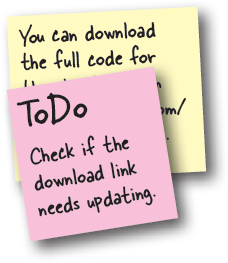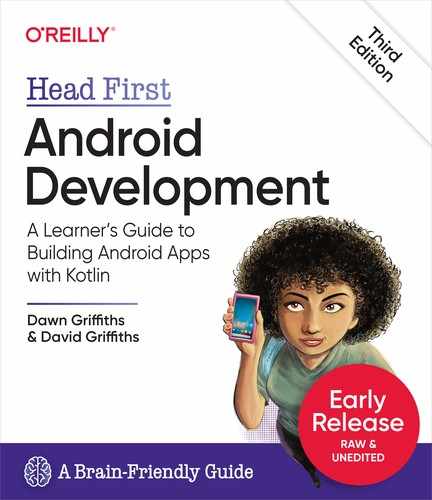Chapter 1. Getting Started: Diving In

Android has made a huge splash in the world.
It’s the most popular mobile operating system on the planet, and there are billions of Android users worldwide, all waiting to download your next great idea. In this chapter, you’ll find out how to start turning your ideas into reality by building a basic Android app, and updating it. You’ll learn how to run it on physical and virtual devices. Along the way, you’ll meet two of the core components of all Android apps: activities and layouts. All you need to get started is a little Kotlin know-how. Let’s dive in...
Welcome to Androidville
Android is the world’s most popular mobile platform. At the last count, there were over 2.5 billion active Android devices worldwide, and that number is still growing.
Android is a comprehensive open source platform based on Linux and championed by Google. It’s a powerful development framework that includes everything you need to build great apps. What’s more, it enables you to deploy those apps to a wide variety of devices—phones, tablets, and more.
So what makes up a typical Android app?
We’re going to build our Android apps using a mixture of XML and Kotlin.
Layouts define what each screen looks like
A typical Android app is composed of one or more screens. You define what each screen looks like using a layout to define its appearance. Layouts are usually defined using a UI editor or XML, and can include components such as buttons, text fields, and labels.

Activities define what the app does
Layouts only define the appearance of the app. You define what the app does using one or more activities. An activity is a special class that decides which layout to use and tells the app how to respond to the user. As an example, if a layout includes a button, you need to add code to the activity to define what the button should do when you press it. Activities are usually written in Kotlin.

Extra resources may be needed too
In addition to activities and layouts, Android apps often need extra resources such as image files and application data. You can add any extra files you need to the app.
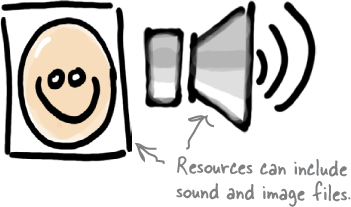
Android apps are really just a bunch of files in particular directories. When you build your app, all of these files get bundled together, giving you an app you can run on your device.
Activities and layouts form the backbone of your app
Layouts and activities work together to define your app’s user interface. The layouts tell Android how the different screen elements should be arranged, and the activities control the app’s behavior. If your app features a button, for example, the layout specifies its position, and the activity controls what happens when the user presses it.

Here’s how activities and layouts work together when you run an app on your device:
Android starts the app’s main activity.
The activity tells Android to use a specific layout.
The layout is displayed on the device.
The user interacts with the layout.
The activity responds to these interactions, and updates the display...
...which the user sees on the device.

Now that you have an idea about how Android apps are put together, let’s go ahead and build a basic Android app.
Here’s what we’re going to do
So let’s dive in and create an Android app. There are just a few things we need to do:
Set up a development environment.
We need to install Android Studio, which includes all the tools you need to develop Android apps.
Build a basic app.
We’ll build a simple app using Android Studio that will display some sample text on the screen.
Run the app.
We’ll run the app on a physical device an a virtual one to see it up and running.
Change the app.
Finally, we’ll tweak the app we created, and run it again.
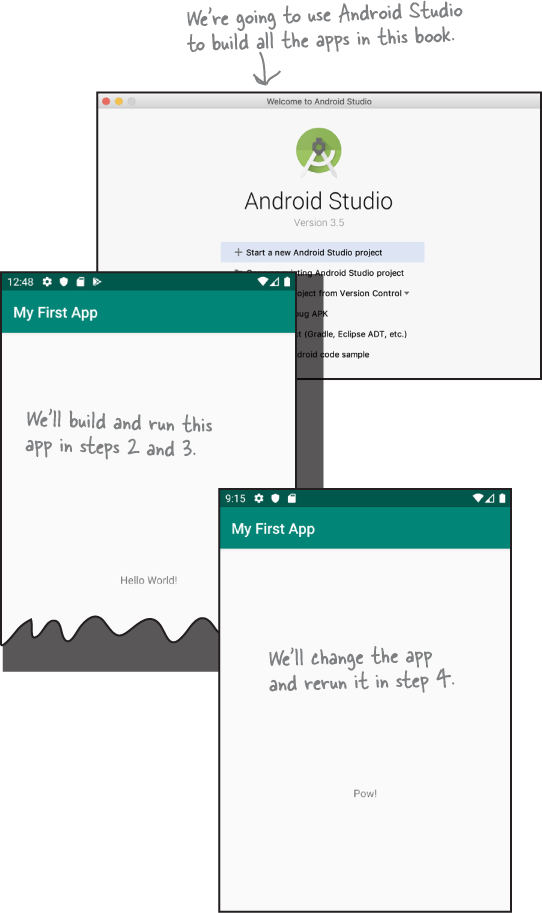
Android Studio: your development environment
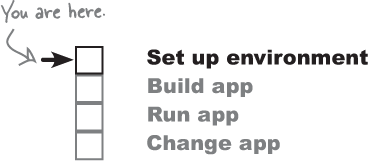
The best way of developing Android apps is to use Android Studio, the official IDE for Android app development.
Android Studio is based on IntelliJ IDEA, which you may already be familiar with. It includes a set of code editors, UI tools and templates, which are all designed to make your life in Androidville easier.
It also includes the Android SDK—or Android Software Development Kit—which is required for all Android app development. The Android SDK includes Android source files, and a compiler that’s used to compile your code into an Android format.
Here are some of the main components of the Android SDK:

You need to install Android Studio
As Android Studio includes all the tools and features you need in order to develop Android apps, we’re going to use it to build all of the apps featured in this book.
Before we go any further, you need to install Android Studio on your machine. There are more details about how to do this on the next page.
Install Android Studio
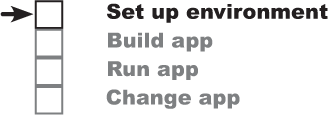
To get the most out of this book, you need to install at least version 3.5 of Android Studio. We’re not including the full installation instructions here as they can get out of date pretty quickly, but you’ll be fine if you follow the online instructions.
First, check the Android Studio system requirements here:
https://developer.android.com/studio#Requirements
Note
Then download Android Studio from here:
https://developer.android.com/studio?pkg=studio
Note
These URLs sometimes change. If they don’t work, search for Android Studio and you should find the appropriate page.
and follow the installation instructions
Once you’ve installed Android Studio, open it and follow the instructions to add the latest SDK tools and Support Libraries.
When you’re done, you should see the Android Studio welcome screen. You’re now ready to build your first Android app.

Build a basic app

Now that you’ve set up your development environment, you’re ready to create your first Android app. Here’s what it will look like:
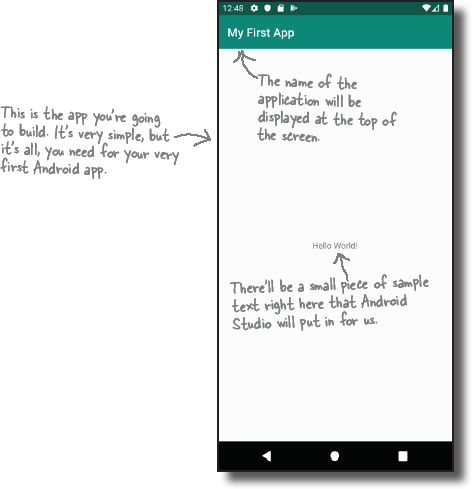
Let’s go ahead and build the app.
How to build the app

Whenever you create a new app, you need to create a new project for it. Make sure you have Android Studio open, and follow along with us.
1. Create a new project
The Android Studio welcome screen gives you a number of options. We want to create a new project, so click on the option for “Start a new Android Studio project.”
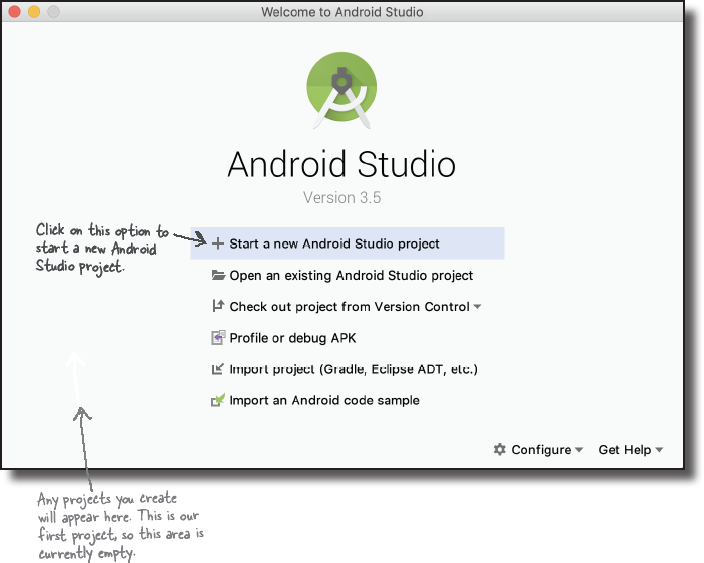
2. Choose your project

You need to specify the type of Android Studio project you want to create. We’re going to create an app with an empty activity that runs on a phone or tablet, so make sure the Phone and Tablet option is selected and choose the Empty Activity option. You’ll find out more about what the Empty Activity option gives you a few pages ahead, but for now, click the Next button to move to the next step.

3. Configure your project

You now need to configure your project by specifying a project name, package name and save location. The package name is used as a unique identifier for your app. Enter a name of “My First App”, a package name of “com.hfad.myfirstapp”, and accept the default save location.
You also need to tell Android Studio which programming language you want to use, and specify a minimum API level. This refers to the lowest version of Android your app will support: there’s more about API levels on the next page.
Select Kotlin for the language, choose a minimum API level of API 19 so that the app will run on older devices. When you click on the Finish button, Android Studio will create your project. We’ll look at what this involves a couple of pages ahead.
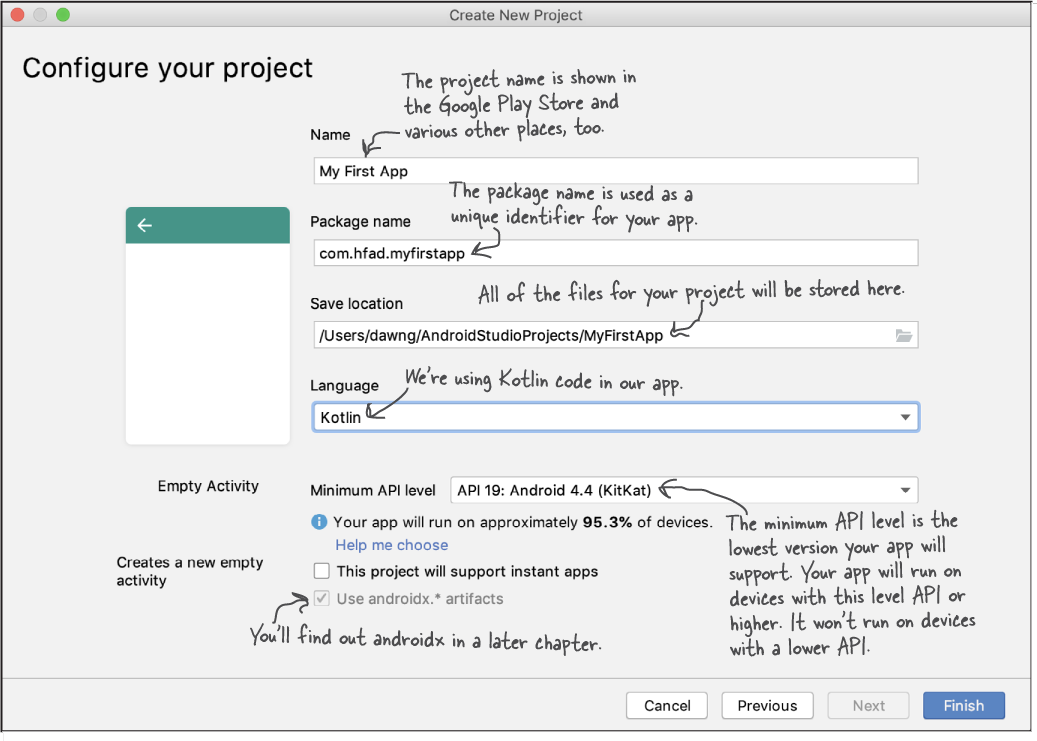
You’ve created your first Android project
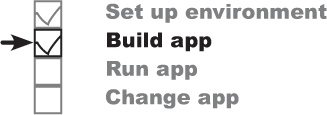
Once you’ve been through the New Project wizard, it takes Android Studio a minute or so to create the project. During this time, it does the following:
It configures the project to your specifications.
Android Studio looks at the minimum API level you want your app to support, and it includes all of the files and folders needed for a basic valid app. It also sets up the package structure and names the app.
It adds some template code.
The template code comprises of a layout written in XML and an activity written in Kotlin. You’ll find out more about these later in the chapter.
When Android Studio has finished creating the project, it automatically opens it for you.
Here’s what our project looks like (don’t worry if it looks complicated—we’ll break it down over the next few pages):

Dissecting your new project

An Android app is really just a bunch of valid files in a particular folder structure, and Android Studio sets all of this up for you when you create a new app. The easiest way of looking at this folder structure is to use the explorer in the leftmost column of Android Studio.
The folder structure includes different types of files
The explorer contains all of the projects that you currently have open. Here, we have a single project named MyFirstApp which is the one we’ve just created.
If you browse through the various folders in the explorer, you’ll see that the wizard has created various types of files and folders for you.
Kotlin and XML source files
Android Studio automatically created an activity file named MainActivity.kt, and a layout named activity_main.xml.
Resource files
These include default image files, styles your app might use, and any common
Stringvalues used by your app.Android libraries
In the wizard, you specified the minimum API level you want your app to be compatible with. Android Studio makes sure your app includes the relevant Android libraries for that version.
Configuration files
The configuration files tell Android what’s included in the app, and how the app should run.

Let’s take a closer look at some of the key files and folders in your project.
Introducing the key files in your project

Android Studio projects use the Gradle build system to compile and deploy apps, and Gradle projects have a standard structure. Below are some of the key files and folders in that structure you’ll be working with. To see this view of the folder structure, change the explorer view in Android Studio from Android to Project. You do this by clicking on the arrow at the top of the explorer pane, and selecting the Project option.

Edit code with the Android Studio editors

You view and edit files using the Android Studio editors. Double-click on the file you want to work with, and the file’s contents will appear in the middle of the Android Studio window.
The code editor
Most files get displayed in the code editor, which is just like a text editor, but with extra features such as color coding and code checking.
The design editor
If you’re editing a layout, you have an extra option. Rather than edit the code, you can use the design editor, which allows you to drag GUI components onto your layout, and arrange them how you want. The code editor and design editor give different views of the same file, so you can switch back and forth between the two.
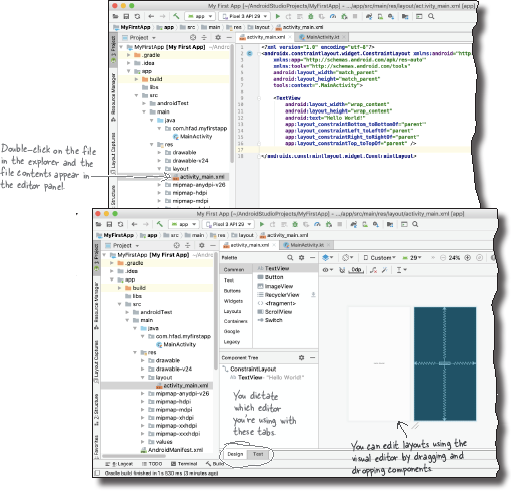
The story so far...

In the chapter so far, we’ve done two things:
We set up our development environment.
We’re using Android Studio for all our app development needs, so you needed to install it on a machine.
We’ve built a basic app.
We used Android Studio to create a new Android project.
You’ve had a glimpse of what your app looks like in Android Studio, and got a feel for how it hangs together. But what you really want is to see it running, right?
Android Studio lets you run an app in two ways: on a physical Android device, and on a virtual one. We’ll show you each approach a few pages ahead.
How to run the app on a physical device

If you have an Android device that’s running KitKat or above, you can use it to run the app we’ve just created.
Note
You can check this by looking at the Android version in the device settings. KitKat is version 4.4, so it needs to 4.4 or higher.
Here are the steps you need to go through to run your app on a physical device:
1. Enable USB debugging on your device
To allow Android Studio to run apps on your device, you need to enable USB debugging. This feature is available in the “Developer options” setting, which is disabled by default.
On your device, go to Settings □ About Phone and tap the build number seven times. This enables the developer options. Then, go to Settings □ System □ Advanced □ Developer options, and turn on USB debugging.
Note
Yep, seriously.
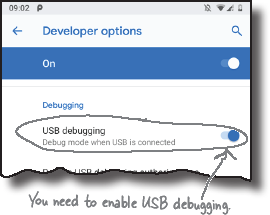
2. Set up your computer to detect the device
If you’re using a Mac, you can skip this step.
If you’re using Windows, you need to install a USB driver. You can find the latest instructions here:
http://developer.android.com/tools/extras/oem-usb.html
If you’re using Ubuntu Linux, you need to create a udev rules file. The latest instructions on how to do this are here:
http://developer.android.com/tools/device.html#setting-up
When we created the app, we specified a minimum API level of 19 (KitKat). Your device needs this version of Android or above for the app to run.
3. Use a USB cable to plug your device into your computer
You will probably be asked if want to accept an RSA key that allows USB debugging with your computer. If so, check the “Always allow from this computer” option and choose OK.
4. Run your app
Finally, make sure that the device is selected in the list of devices in Android Studio’s top toolbar, then run the app by choosing “Run ‘app’” from the “Run” menu. Android Studio will build the project, install the app on your device and launch it.
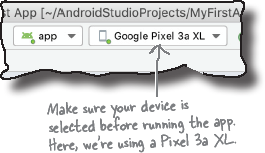
We’ll look at the app a few pages ahead, after we’ve seen how to run it on a virtual device.
How to run the app on a virtual device

If you don’t have an Android device to hand or it doesn’t have the right version of Android, you can run the app on a virtual device instead. Running your app on a virtual device is useful if you want to see how your app looks on a type of device you don’t own, or test how it behaves on a different version of Android.
You can set up numerous Android Virtual Devices (AVDs), each emulating a different device or Android version.
The Android SDK features a built-in emulator which you can use it to set up one or more Android virtual devices (AVDs). Once you’ve set up an AVD, you can run your app on it as though it’s running on a physical device.
The emulator recreates the exact hardware environment of an Android device: from its CPU and memory through to the sound chips and the video display. The emulator is built on an existing emulator called QEMU (pronounced “queue em you”), which is similar to other virtual machine applications you may have used, like VirtualBox or VMWare.
The exact appearance and behavior of the AVD depends on how you set it up. If, say, you create an AVD based on a Pixel 3 running Android 10, it will look and behave just like a Pixel 3 running this version of Android on your computer.
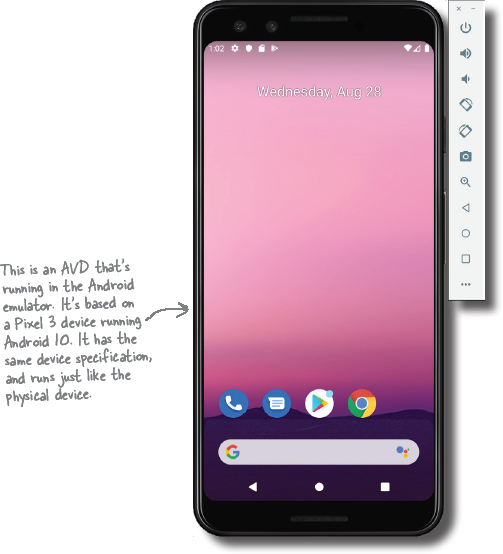
Let’s set up an AVD so that you can see the app running in the emulator.
Create an Android Virtual Device (AVD)

There are a few steps you need to go through in order to set up an AVD within Android Studio. We’ll set up a Pixel 3 AVD running API level 29 (Android 10) so that you can see how your app looks and behaves running on this type of device. The steps are pretty much identical no matter what type of virtual device you want to set up.
Open the Android Virtual Device Manager
The AVD Manager allows you to set up new AVDs, and view and edit ones you’ve already created. Open it by selecting AVD Manager on the Tools menu.
If you have no AVDs set up already, you’ll be presented with a screen prompting you to create one. Click on the “Create Virtual Device” button.

Select the hardware
On the next screen, you’ll be prompted to choose a device definition. This is the type of device your AVD will emulate. You can choose a variety of phone, tablet, wear, or TV devices.
We’re going to see what our app looks like running on a Pixel 3 phone. Choose Phone from the Category menu and Pixel 3 from the list. Then click the Next button.
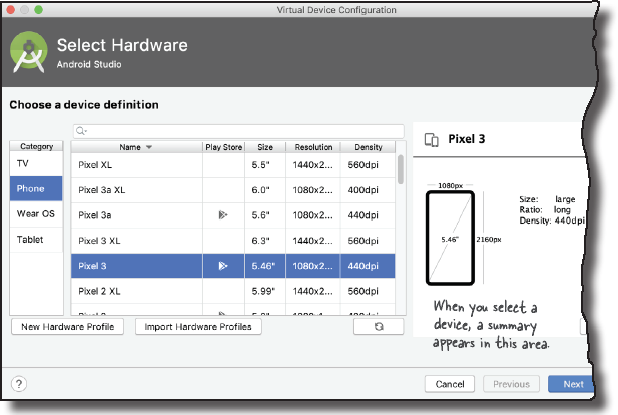
Select a system image

Next, you need to select a system image. This specifies which version of Android you want to be on your AVD.
You need to choose a version of Android that’s compatible with the app you’re building. It must be at least the minimum API level that your app supports.
When we created ourAndroid project, we specified that the minimum API level is API level 19. This means that you need to choose a system image that’s for API level 19 (KitKat) or above. If you choose an older version of Android than this, the app won’t be able to run on the device
Here, we’re going to see what the app looks like on a relatively new version of Android, so choose the system image with a release name of Q and a target of Android 10.0 (API level 29). Then click on the Next button.

Verify the AVD configuration

On the next screen, you’ll be asked to verify the configuration. This screen summarizes the options you chose over the last few screens, and gives you the option of changing them. Accept the options, and click on the Finish button.
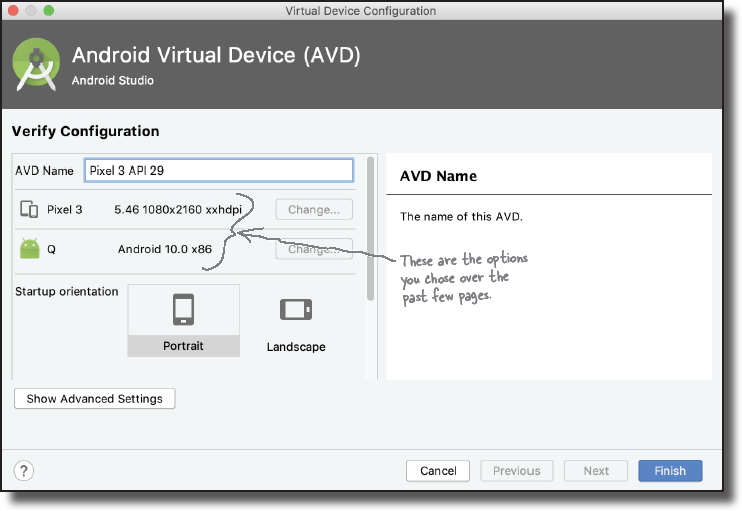
The virtual device gets created

When you click on the Finish button, the Device Manager creates the virtual device for you, and displays it in the AVD Manager’s list of virtual devices like this:

Check the new AVD is listed, then close the AVD Manager.
Run the app on the AVD
Once you’ve created the AVD, you can run the app on it.
To run the app, ake sure that the virtual device is selected in the list of devices in Android Studio’s top toolbar, then run the app by choosing the “Run ‘app’” command from the Run menu.
The AVD can take a while to load, so while we wait, let’s take a look at what happens behind the scenes when you use the Run command.

Compile, package, deploy, run
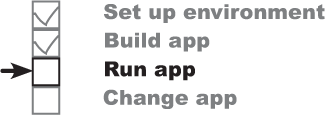
The Run command doesn’t just run your app. It also handles all the preliminary tasks that are needed for the app to run.
Here’s an overview of what happens:
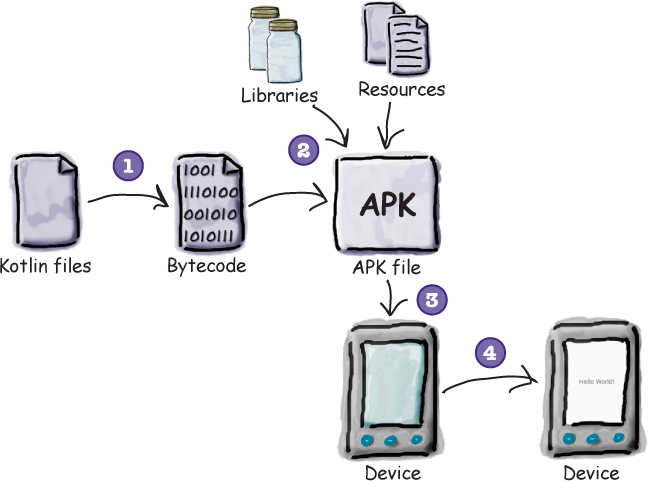
An APK file is an Android application package. It’s like a ZIP or JAR file for Android applications.
The Kotlin source files get compiled to bytecode.
An Android application package, or APK file, gets created.
The APK file includes the compiled Kotlin files, along with any libraries and resources needed by your app.
The APK is installed on the device.
If the device is virtual, Android Studio launches the emulator and waits until the AVD is active before installing the APK.
If the device is physical, it just installs the APK.
The device starts the app’s main activity.
The app is displayed on the device screen, and it’s all ready for you to play with.
Now that you know what happens when you use the Run command, let’s see what the app we’ve built looks like.

Test drive

Make sure you’ve run the app on a physical or virtual deviceby choosing the “Run ‘app’” command from the Run menu.
Android Studio loads the app onto the device and starts it. The app name “My First App” appears at the top of the screen, and the text “Hello World!” is displayed in the center.

Let’s run through what just happened.
What just happened?

Let’s break down what happens when you run the app:
Android Studio installs the app on the device.
If the device is virtual, it waits for the emulator to start before installing the app.

Android starts the app’s main activity.
It uses the code in MainActivity.kt (which Android Studio automatically included in the project) to create an activity object.
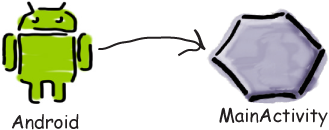
MainActivity specifies that it uses the layout activity_main.xml.

The layout is displayed on the screen.
The text “Hello World!” appears in the center of the screen.
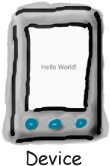
Refine the app

So far in this chapter, you’ve built a basic Android app and seen it running on a physical or virtual device. Next, we’re going to refine the app.
At the moment, the app displays the sample text “Hello World!” that the wizard put in as a placeholder. You’re going to change that text to say something else instead. So what do we need to change in order to achieve that? To answer that, let’s take a step back and look at how the app is currently built.
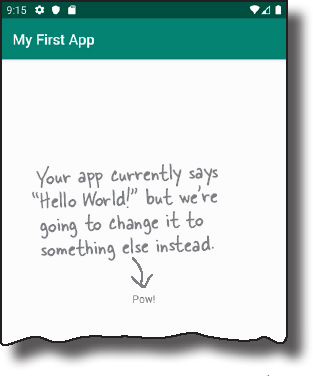
The app has one activity and one layout
When we built the app, we told Android Studio how to configure it, and the wizard did the rest. The wizard created an activity for us, and also a default layout.
The activity controls what the app does
Android Studio created an activity for us named MainActivity.kt. The activity specifies what the app does and how it should respond to the user.
The layout controls the app’s appearance
MainActivity.kt uses the layout Android Studio created for us named activity_main.xml. The layout specifies what the app looks like.
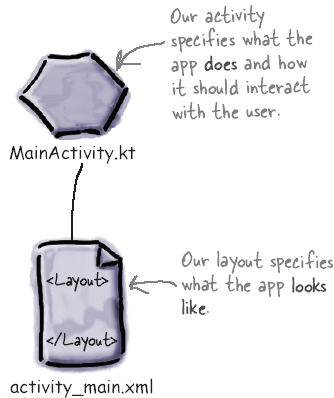
We want to change the appearance of the app by changing the text that’s displayed. This means that we need to deal with the Android component that controls what the app looks like, so we need to take a closer look at the layout.
What’s in the layout?

We want to change the sample “Hello World!” text that Android Studio created for us, so let’s start with the layout file activity_main.xml. Open it now (if it’s not already open) by finding the file in the app/src/main/res/layout folder in the explorer and double-clicking on it.

The design editor
As you learned earlier, there are two ways of viewing and editing layout files in Android Studio: through the design editor and through the code editor.
When you choose the design option, you can see that the sample text “Hello World!” appears in the layout as you might expect. But what’s in the underlying XML?
Let’s see by switching to the code editor.
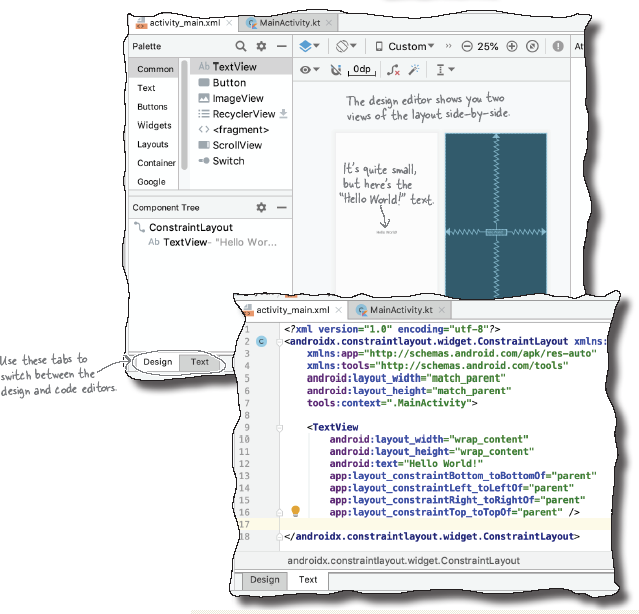
The code editor
Switch to the code editor by clicking on the Text tab at the bottom of the editor. This shows you the layout’s underlying XML.
Let’s take a closer look at the code.
activity_main.xml has two elements
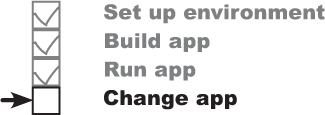
Below is the code from activity_main.xml that Android Studio generated for us. We’ve left out some of the details you don’t need to think about just yet; we’ll cover them in more detail through the rest of the book.
Here’s our code:


As you can see, the code contains two elements.
The first is an <...ConstraintLayout> element. This is a type of layout element that tells Android how to display components on the device screen. There are various types of layout element available for you to use, and you’ll find out more about these later in the book.
The most important element for now is the second element, the <TextView>. This element is used to display text to the user, in our case the text “Hello World!”
The key part of the code within the <TextView> element is the line starting with android:text. This is a text property that describes the text that should be displayed:

We’ll change the text to something else after you’ve had a go at the following exercise.
Update the text displayed in the layout

We want to change the text in activity_main.xml so that when we run the app, it displays something other than “Hello World!”. We can do this by changing the text property in the layout’s <TextView> element:

The text property is defined inside the <TextView> element using the code android:text. It specifies what text should be displayed, in this case “Hello World!”

To update the text that’s displayed in the layout, simply change the value of the text property from "Hello World!" to some other text, such as "Pow!". The new code for the <TextView> element should look like this:

That’s the only change you need to make in order to update the text. Let’s see what happens when the code runs.
What the code does

Before we take the app for a test drive, let’s go through what the code does.
Android uses MainActivity.kt to create the activity object MainActivity.

MainActivity specifies that it uses the layout activity_main.xml.

The layout displays the text “Pow!” in the center of the app on the device.
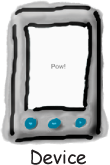
Let’s run the app.

Test drive
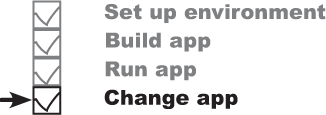
Once you’ve edited the file, try running your app in the emulator again by choosing the “Run ‘app’” command from the Run menu. You should see that your app now says “Pow!” instead of “Hello World!”

Congratulations, you’ve now built and updated your first app, and learnt how Android apps hang together in the process. We’ll build on this further in the next chapter by creating an interactive app.
Your Android Toolbox

You’ve got Chapter 1 under your belt and now you’ve added Android basic concepts to your toolbox.
